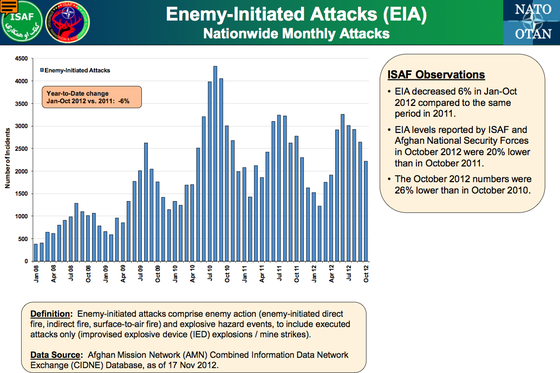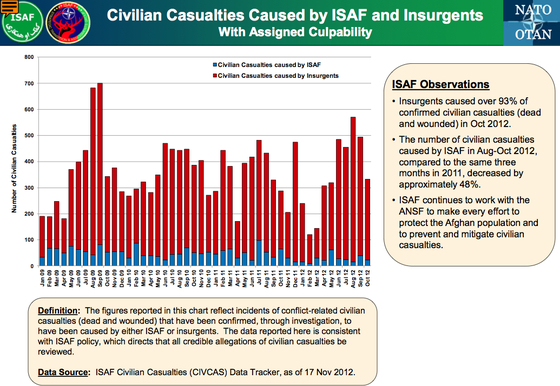During a speech at the Center for a New American Security in Washington, DC last week, Secretary of Defense Leon Panetta said that by "nearly every indication," the insurgency in Afghanistan "has been significantly weakened."
To support his case, Panetta cited an assessment by NATO's International Security Assistance Force (ISAF) conducted earlier this month, "following the end of the fighting season, and the conclusion of the surge."
"Violence levels, which had increased for five years, decreased in 2011, and 2012," Panetta said.
The most recent data released by ISAF to the public tell a more complicated story. It is true that the overall level of violence in Afghanistan decreased in 2011, and thus far in 2012, when compared to 2010. But 2010 was peak year in terms of the number of "enemy-initiated attacks" (EIAs), the chief metric used by ISAF to measure violence. And the number of EIAs so far this year remains much greater than in 2009, the year prior to the American-led surge.
The figures for October 2012 illustrate the point. ISAF's latest publicly-available data were released on Nov. 22 and cover the first 10 months of 2012.
The number of EIAs in October 2012 was 20 percent lower than that for the same month in 2011, and 26 percent lower than the comparable figure for 2010. But there were still hundreds of more EIAs in October 2012 than in October 2009. While ISAF does not release precise figures, a bar chart included in the Nov. 22 presentation shows that there were between 2,000 and 2,500 EIAs in October 2012, significantly more than the 1,500 to 2,000 EIAs in October 2009.
In the previous month, September 2012, the number of EIAs actually increased slightly when compared to 2011.
Over the first 10 months of 2012, the number of EIAs has been far greater than in 2009.
A look at ISAF's count of civilian casualties illustrates a further complication. While the number of EIAs has decreased as compared to 2010, the number of civilian casualties (killed and wounded) has actually increased in 2012 as compared to 2011.
The number of civilian casualties in October 2012 was between 300 and 350, according to ISAF. In October 2011, that figure was less than 300. The figures for August and September 2012 were far higher than those for the same months in 2011.
The increase in civilian casualties has occurred despite a drastic reduction in the number of ISAF-caused casualties. That is, the Taliban-led insurgency remains capable of causing several hundred civilian casualties each month, with no discernible improvement in ISAF's figures for 2012.
The surge of forces in Afghanistan has improved the security situation in some areas. After arguing that the "signs of progress are real," Panetta added that "so are the challenges that remain."
"This is an insurgency that is resilient, and they will do everything they can to project an appearance of strength to Afghans and to the international community," Panetta said.
Panetta also warned that while "al Qaeda, the Taliban, and other associated forces" are "under pressure in Pakistan," they "continue to view the rugged terrain of northeastern Afghanistan, especially Kunar and Nuristan provinces, as a viable safe haven."
For more on ISAF's data analyses, see LWJ reports: Analysis: The Taliban's 'momentum' has not been broken, ISAF data show insurgent attacks down, civilian casualties up, and ISAF data show insurgent attacks, civilian casualties increased in September.

